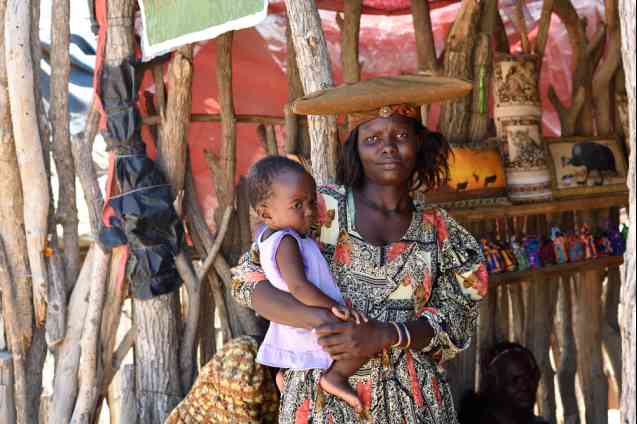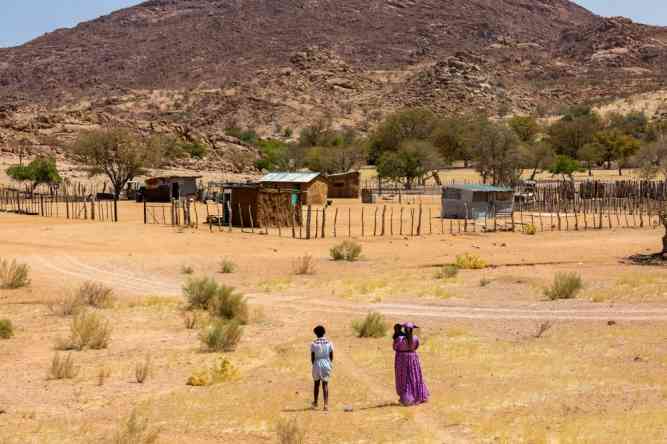Who are the Herero people of Namibia & why are they famous fashion icons?
The Herero people are arguably the most culturally recognizable tribe in Namibia. Herero women are famous for their bright and colourful ankle-length dresses, high necklines, tight bodices, and long puffed sleeves. Adapted from European fashion in the Victorian period, the style of the dress is now regarded as a cultural tradition. The dresses are handmade, and worn with a cloth headdress that symbolizes cattle horns, and a point of much pride.
Like the Maasai in East Africa, the Herero are historically nomadic herders with cattle forming an important part of their culture. In modern times Herero activists like Chief Hosea Kutako (after whom the international airport in Windhoek is named) figured prominently in the quest for Namibian independence. In this blog post, we will explore the history, culture, and modern-day situation of the Herero people, shedding light on this little-known but significant part of Namibia's diverse cultural tapestry.
 The Himba are a sub-group of the Herero African tribe
The Himba are a sub-group of the Herero African tribe
Who are the Herero of Namibia?
The Herero people of Namibia are a fascinating group with a rich and complex history. Their unique culture and traditions have been shaped by centuries of interaction with other African tribes, as well as with European colonizers. Though thought of as a single tribe, the Herero are not homogenous and include sub-groups like the Himba, Kuvale, and Tjimba. It is thought that the original Namibian Herero-speaking people are the Himba from Kaokoveld in the north. The southern groups are today known as the Herero proper and occupy the central parts of Namibia. Today, the Herero remain a distinct ethnic group, proud of their heritage and determined to preserve their traditional way of life in the face of modernization.
How did the Herero get to Namibia?
The Herero people are believed to have migrated from East Africa into present-day Namibia around the 16th century. As a pastoralist community, they brought with them large herds of cattle, sheep, and goats. The Herero established themselves as successful cattle farmers and developed a sophisticated social structure based on their livestock. Pre-colonial Herero society was organized into clans, led by a chief, and governed by customary laws that regulated marriage, inheritance, and property rights. The Herero people were able to thrive in Namibia's semi-arid environment by utilizing their herds for food and trade, and by adapting their practices to the local climate and geography.
Tragic pasts, colonization, & genocide
Unfortunately, the history of the Herero people in Namibia is also marked by tragedy and suffering. In the late 19th century, Germany established a colony in what is now Namibia and implemented policies that stripped the Herero people of their land and resources. In 1904, after years of resistance to colonial rule, the Herero people launched an uprising against the German occupiers. In retaliation, the German military launched a brutal campaign of violence, leading to what is now widely recognized as the first genocide of the 20th century. Between 50,000 and 65,000 thousand Herero were shot, poisoned, or driven into the desert to die. Many more were subjected to forced labour and internment in concentration camps. The surviving Herero people were forced into reserves, where they were subject to further exploitation and mistreatment. It is believed that the genocide wiped out about 85% of the Herero during this period. Today, the legacy of this colonial violence and genocide continues to shape the experiences of the Herero people in Namibia.
 Herero woman sewing in Namibia
Herero woman sewing in Namibia
19th Century Relics: The Herero Dress
In a fascinating twist, the Herero women have adopted and adapted colonial-era dress into a culturally dynamic and unique art form. The Herero dress, known as Ohorokova, is a Victorian-style gown adorned with cow horn-like headdresses. The dresses have become an iconic symbol of the Herero people. The dress was introduced by German colonizers in the late 19th century, as a way to enforce European customs and modesty among the Herero women. However, the Herero have claimed the style as their own. The Victorian-style dresses have become uniquely African, endowed with colour vibrancy, and flair all their own. For their part, Herero men have adopted military-style uniforms, in recognition of their warrior ancestors who fought against the German oppressors. Both men and women believe that by adopting the style of dress of their oppressors, they diminish their power. Today, these colourful traditional outfits are worn during traditional ceremonies and festivals and have become an important aspect of the Herero cultural identity.
A Living Fashion: The Herero Dress in Contemporary Namibia
The Ohorokova is not just a relic of the past, but a living fashion that continues to be used by young Namibian designers and featured in contemporary Namibian fashion. The dress has been embraced by modern designers and artists who incorporate the iconic cow horns into their designs, creating a fusion of traditional and contemporary styles. In recent years, the Herero dress has gained international attention, being featured in fashion shows and exhibitions around the world. It is a testament to the resilience and creativity of the Herero people, who have taken a symbol of oppression and transformed it into a celebration of their culture and heritage.
 Namibian African tribal attire
Namibian African tribal attire
Interesting Facts about the Herero
- The Herero language is a Bantu language and is spoken by over 200,000 people in Namibia and Botswana.
- During the popular outjina dance, the ‘dance of the cow head’, Herero women stamp their feet and kick up dust and imitate the upraised horns and swaying movements of cattle.
- Ohorokova is handmade and seen as a rite of passage into womanhood for Herero women.
- The modern practice of donning military uniforms stems from the 1908 uprising when Herero men would wear the uniforms of German soldiers they had killed in battle. Today it is a way of honoring their warrior ancestors.
- The wealth of the Herero is measured by the number of cows they have. Their pride in being cattle rearers is reflected in the women’s fashion - the Herero hat or headdress uniquely shaped like the horns of a cow.
- The Herero inherit their place of residence, religion, and authority from the father’s line, while wealth is transferred (inherited) through the mother’s line.
Destination Namibia
The history and culture of the Herero people in Namibia are rich and fascinating. From their pastoralist roots in East Africa to their tragic past and their resilient present, the Herero people have a unique story to tell. Herero culture and traditions continue to thrive today. Their distinctive dress has become a symbol of their identity and is proudly worn by both men and women.
For travellers interested in cultural experiences, Namibia is an intriguing destination. The Herero people are just one of the many diverse cultures to be discovered in this beautiful country. From the stunning landscapes of Etosha and Sossusvlei to the rich cultural experiences of the Himba and San people, Namibia offers a unique and unforgettable African adventure.
To arrange a well-priced Private Namibia Safari, contact African Budget Safaris, or take a look at our affordable Namibia Safari Tours which can be customized for you.
If you liked this post, these trips cover similar ground…
- 12 Day Namibia Self Drive Safari
- 10 Day Explore Namibia Private Safari Tour
- 5 Day Private Namibia Desert & Swakopmund Safari
- 4 Day Private Namibia Safari to Swakopmund & Etosha
- 3 Day Etosha Private Safari in Namibia
- Namibia Safari - Desert, Swakopmund & Etosha Camping Safari
- 12 Day Namibia & Botswana Safari: Swakopmund to Victoria Falls Camping Tour






 On the outskirts of Marloth Nature Reserve, Andrew can be found walking and swimming in the beautiful Langeburg Mountains. He is passionate about animals, birds, reptiles, and plants and loves nothing more than an adventure in nature. An established artist with a master's in English literature, Andrew has traveled far and wide but South Africa still has his heart.
On the outskirts of Marloth Nature Reserve, Andrew can be found walking and swimming in the beautiful Langeburg Mountains. He is passionate about animals, birds, reptiles, and plants and loves nothing more than an adventure in nature. An established artist with a master's in English literature, Andrew has traveled far and wide but South Africa still has his heart.










